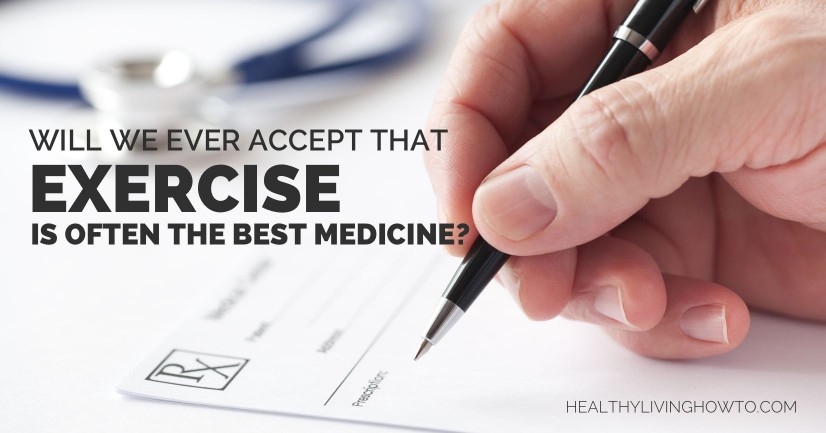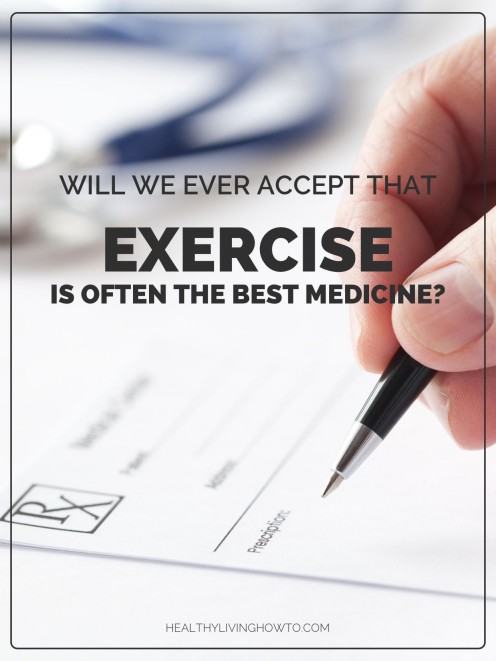For years, experts have known that in mild to moderate cases of depression exercise is as effective (or more effective) a treatment as prescription drugs. Yet, here we are in 2014, with still climbing obesity rates and higher than ever numbers of people taking anti-depressants – a 400% jump in the last 20 years.
This past week, exercise as medical therapy got another round of press after The Atlantic highlighted the issue in their thought provoking feature “For Depression, Prescribing Exercise Before Medication.” Let me add, however, that we aren’t just missing the boat in terms of depression therapy.
Research has shown time and again that exercise offers just as good if not better results for an array of medical conditions.
I might be preaching to the choir with the general theme, but let’s go beyond the basic assumptions and hone in on the critical underlying messages reflecting why exercise isn’t just the safest and often most effective choice but why it so often remains the least accessed therapy.
Yes, the whole picture is profoundly intuitive to any Primal type (or maybe anyone not sold on the pharmaceutical solution to living). Isn’t it a funny, head-scratching coincidence that basic exercise can prevent – and treat – psychological and physical decline? Who would’ve thought that movement was useful to our bodies – that offering our physical forms the activity they were designed to perform for eons would confer some actual benefit?
Still, the actual results themselves are fun if not impressive to read. Consider this…
- Regular exercise resulted in a 30% remission rate for those with depression who didn’t respond to SSRI medication.
- Study participants with heart disease who exercised had the same risk of dying as those who took popular drugs such as statins, antiplatelet drugs or ACE Inhibitors.
- Research subjects with prediabetes who took the array of common prescription medications had the same mortality risk as those who simply exercised.
- Among study subjects who had experienced stroke, those who exercised had a significantly lower mortality risk than those who took medications such as anticoagulants and antiplatelets.
On the flip side of this coin, of course, are the negatives.
We’ve established that exercise confers physical, cognitive and emotional advantages for the prevention and/or treatment of many medical conditions. Add to this equation the question of drawbacks. Does exercise have disadvantages?
In all fairness, your hair gets messed up. You’ll likely sweat. You perhaps need to take an extra shower or time the day’s toilette to match your workout schedule. You need to buy a pair of shoes (but then again you can just go barefoot). You’ll need to invest a little time for heavier workouts but perhaps can try to get some of the low level movement in while using a handy-dandy treadmill desk (or, more old school, work a job with heavy manual labor or lots of activity). Then we come upon the whole inertia argument, but in response there are even effective exercise options for the motivationally challenged.
While I’m not trying to minimize the nuisance of smelly armpits or losing an hour on the sofa, let’s take a look now at the potential downsides of pharmaceutical solutions.
- Side Effects for SSRIs: gastrointestinal disturbances, anxiety, agitation, insomnia, sleep disturbance, weight gain, sexual dysfunction
- Side Effects for Statins: memory loss, forgetfulness, confusion, muscle damage, increased risk of diabetes, liver injury
- Side Effects for Anti-coagulants: excessive bleeding, severe bruising, bloody urine or stool, headache, back pain, chest pain, difficulty breathing
- Side Effects for ACE-inhibitors: dizziness, headache, fatigue, loss of appetite, gastrointestinal problems, diarrhea, numbness, fever, joint pain
- Side Effects for Beta-blockers: diarrhea, stomach cramps, nausea, vomiting, rash, blurred vision, muscle cramps, fatigue, headache, depression, confusion, dizziness, sexual dysfunction, low or high blood glucose
The final kicker? A study out just last month showed that more than 20% of older adults being treated for multiple medical conditions are prescribed medications that worsen the symptoms of another condition. In other words, their medications work at odds or in “therapeutic competition” with each other. The more we dig ourselves into the pharmaceutical hole, it appears, the worse (and more ironic) it all gets.
![Exercise Is Often The Best Medicine | healthylivinghowto.com]() Knowing all of this, why does the obvious solution feel so impossible?
Knowing all of this, why does the obvious solution feel so impossible?
Why won’t people accept exercise as a genuine medical option? Why do we tend to go with a pill (at times, an awfully expensive one) rather than a simple, natural behavior change? Why are we individually invested in this choice? Why are we as a culture – or medical establishment – so invested in this approach?
We’ll spend billions of dollars researching which gene “lights up” or which protein levels rise all in the name of better understanding the physiological mechanisms of disease while the solution itself is staring us in the face.
Let me back up for a moment and suggest that I’m not arguing that exercise covers any and all medical need. I’m not saying it has the absolute power to cure or prevent any particular person from developing illness in his/her lifetime. Our physiology is inherently complex. People should avail themselves of the broad medical options that allow them to lead the fullest and healthiest lives possible.
That said, there’s rarely an instance in which lifestyle choices can’t make a powerful difference either unto themselves or in conjunction with conventional or complementary medical treatments.
The million dollar question in all this, of course, is how do we get people to accept exercise as a treatment?
How do we convince doctors to literally prescribe exercise (understanding, of course, that some already do)? How can patients be convinced to avail themselves of the safest, perhaps most effective treatment option? The Atlantic feature chose to address this question from the perspective of psychiatrists. Their answer? To treat it “like real medicine.” For one psychiatrist interviewed, that means addressing it in his appointments with patients as he would a prescription for medication, discussing the details of studies that support the effectiveness of exercise, talking about effective “doses” and intensity levels, emphasizing the importance of consistency by comparing it to a diabetic’s occasional versus regular use of insulin.
It’s a provocative thought.
What if doctors talked about exercise as medicine in their sessions?
Would it be convincing to the majority of people who walk through their doors? (Would it win you over?) The results, according to doctors in The Atlantic piece, seem mixed. The most difficult factor is the obvious elephant in the living room – that the pill is there ready to be prescribed, whether it’s called “a last resort” or not.
Nonetheless, can the rhetoric sway at least some people to take exercise to heart? Will homing in on the technical details of dosage and variety get people to take the usually friendly advice as medical law – and personal treatment plan?
There’s an interesting wrinkle to this that I don’t often see discussed with how we tend to downplay the value of lifestyle interventions. Research into the placebo effect demonstrates that the more costly we believe a certain placebo “medication” is, the higher we rate its “effectiveness” in treating our symptoms. The value we attach to a treatment influences the actual results we think we experience.
This point, in turn, brings up another dimension. While we (rightly) exalt the everyday accessibility of exercise, are we simultaneously downgrading its appeal to those who need it most? Let’s just brainstorm for a minute.
What would happen if doctors could prescribe personal training and/or fitness center/class use as they do physical therapy?
People often skip physical therapy or bow out before they’ve met their goals, but generally people take advantage of it when a doctor orders it. Would it boost people’s buy-in if we promoted general fitness training and support the same way? Are we kidding ourselves to think we can put the onus solely on the individual when the system so clearly supports the opposite choices?
There’s an interesting cultural dichotomy at work here. I think a lot of ordinary people would bristle at the suggestion that they need a trainer or that this person’s service should cost them in treating their illness. Yet, they think nothing of spending as much or considerably more on medications than they would the guidance (and motivation) of a personal trainer. Simultaneously, there’s an odd fascination with the most extreme representation of the trainer figure as millions watch Jillian Michaels et al. every week in the disturbing entertainment of televised panopticon meets “fat camp.” We’re a confounding, nonsensical populace (collectively speaking)….
On the other end of the “medical speak,” when prescribing exercise is the self-care justification.
You deserve to take care of yourself. You deserve to thrive. You deserve to not have to take insulin every day or deal with the complications of statins.
Is this line of reasoning any more convincing for people than dosing out activity according to medical study suggestion? My own sense is it depends on the patient.
Either way, it always intrigues me how put out we are by our bodies’ needs. Are we naturally this lazy, or has the culture just gotten to us that we feel so put upon having to exercise ourselves – having to make the effort to pick up our 100 lb gym shoes and walk out that 1000 lb front door to go for a walk? That hour we have to “waste” on fitness could’ve been used for three dozen other, more pressing needs. Why not see a pill as the ultimate “easy button” that allows us to have it all. It’s hard to kick the collective faith in that assumption even if the research suggests a much different picture.
Where does medical logic fit in a modern mindset?
It’s hard to tell, but the simple Primal perspective as always holds – that we naturally live through our bodies and have the ability to physically and psychologically thrive when we offer ourselves the age-old inputs our genetic blueprints anticipate. Maybe Primal logic’s time has come.
Written by Mark Sisson and originally published at MarksDailyApple.com syndicated with exclusive permission for Healthy Living How To. Pick up your copy of The Primal Blueprint and visit Mark’s Daily Apple for daily articles on how to live a healthy Primal lifestyle in the modern world.

